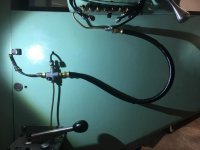If you've found some 37 year old mothballed, nearly unused Bridgeport mill with minimal wear and all it has is a plugged up Bijur? I'd snag it up and break the machine down into it's major components. Remove the table, remove the knee and IMO I'd break down the powerhead (just the power head part, not the more complicated quill and autofeed mechanism etc). I just bought my first Bridgeport a couple months ago and I didn't know anything about how they were put together (although I am mechanically inclined and I do have an extensive tool collection).
It's not that hard really, it's a pretty simple machine. I used my adjustable hydraulic motorcycle stand to support the weight of my table when sliding it on and off. I manually took the saddle off after that. Then I used my HF 2 ton hoist to elevate and remove the knee. Then I got into every nook and cranny and cleaned out all the trapped chips jammed into the various wear points, mostly between the ways (and you will probably find plenty, considering it was used for ten years before going into storage).
Then I tested the exposed Bijur system. It mostly worked, but it did have a plugged up port or two. I cleaned those out until I had full flow in all ports. I also noticed two of the Bijur lubricating lines under the table were disconnecting from the cross-nut. I reconnected them, thereby restoring full lubrication to all required locations. Before reassembly, I cleaned all the X, Y and Z leadscrews and nuts to shiny metal. Cleaned, adjusted and lubricated the 90 deg gearbox inside the knee (that's connected to the Z axis crank handle). Everything else was thoroughly cleaned and luricated. After reassembling the saddle and table, I replaced the felt wipers on the Y and Z axis (none for X) to keep chips out. I plan to get a piece of rubber sheet or a bellows arrangement to keep further chips from getting into the ways, I'd advise similar if you're lucky enough to have a minimal wear machine. You want to keep it that way if you plan on keeping the machine for a long time.
My machine had a noisy variable speed head so I decided to buy a rebuild kit from H&W and rebuild it. Again, it really wasn't that hard, and again I had no experience working on Bridgeports. H&W has excellent instructional videos on youtube that I watched that really help. And I'm glad I did go into the head, because the grease that lubricates the bullgear and pinion gear (i.e. the High/Low system) was all dried up. I cleaned out all the dried up goop and replaced it with fresh grease. I also had plugged up grease passageways in the head and cleaned them out with a wire and solvent. Had I not broken the head down, I never would have known that or been able to fix it.
The ram and the tilt head were very gummed up and had some rust on the ways. So I decided to also remove the ram using my HF hoist. This part was very easy to do. I cleaned everything up by vacuuming out all the chips everywhere. Then using WD40 and a scotchbrite pad to clean the ways, the rack and pinion gear system and also the nod-tilt head gear system. And again, once I had it apart it had all this dried up grease in the head rotation worm gear drive system (the system that allows you to rotate the head clockwise or counterclockwise and invert it by cranking on the nut on the side of the head). I cleaned out all the dried up grease and pack fresh grease in there. Oiled the now shiny clean ways and rack and pinion system on the ram with way oil, put it all back together and now everything works better than new. The ram now slides so easily I can move it with one finger and if I'm not careful it will slide off the turret part! (actually there is a stop, but it slides like glass now) Same for the nod and turret rotating part. Everything is clean, lubricated and adjusted to work perfectly. Much nicer than before.
Anyway, IMO that's what I would do. I thoroughly enjoyed breaking my machine down and learning all about it. And since I didn't go into the deep mechanical part of the head, all systems really were quite simple and easy to understand. And it didn't take that long either. Plus I fixed all the dried up grease problems, stuck Bijur valves and cleaned out all the deeply jammed chips packed deep into the ways (endlessly chafing my ways down with every table movement). Now my machine is all cleaned up, properly lubricated, properly adjusted, easy to use and set up to last the rest of my lifetime with minimal fuss.



